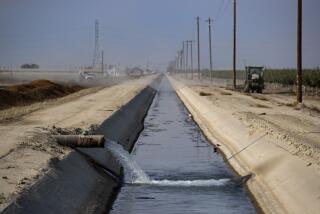Group Warns of Worldwide Water Crisis
- Share via
WASHINGTON — Burgeoning populations and aging technology have brought the world to the brink of a water crisis, an environmental think tank said Saturday.
A Worldwatch Institute study warned that the 1990s could see a water crunch similar to the oil crisis of the 1970s.
In two decades, per capita water supplies have declined by one-third and people have been multiplying faster than irrigated lands can expand, the study said.
“This trend of declining irrigated land per person is historically new, and political leaders and development specialists have not yet fully grasped its consequences,” said the study, titled “Last Oasis,” written by the group’s vice president, Sandra Postel, and supported by a grant from the Ford Foundation. “Indeed, many have failed even to notice it.”
Water-guzzling toilets, leaky pipes in the world’s oldest cities, overly thirsty crops, government-subsidized irrigation and industries that gorge on water all contribute to the problem, Postel said.
The Worldwatch study also found that:
* Per capita grain production has been falling roughly 1% a year since 1984, with the drop concentrated in developing countries.
* Construction of irrigation projects will be increasingly difficult in the future.
* Some existing irrigated lands will have to give up water to meet rapidly growing urban demands.
* The future is likely to see no more than a 1% annual increase in irrigated farmland, while the world’s population is expected to increase by about 1.7% a year.
“With some 95 million people being added to the planet each year in the 1990s,” Postel said, “new strategies will be needed to prevent the many emerging irrigation constraints from leading to food shortages.”
The report said 26 countries with populations totaling more than 232 million--including 11 in Africa and nine in the Middle East--are now seriously water-deficient; high birthrates exacerbate the problem.
By the year 2000, the population of Africa’s water-scarce countries will climb to 300 million, while six of the nine Middle Eastern nations already facing shortages will see their populations double, the study said.
“Water scarcity will affect everything from prospects for peace in the Middle East to global food scarcity, the growth of cities and the location of industries,” Postel said.
Postel’s thesis is that rather than trying to increase the available water supply through dam-building and well-digging, conservation and more efficient water use offer humanity its “last oasis.”
The aging irrigation technologies used around the world are about 40% efficient, which means less than half the water diverted for agriculture actually reaches the crops for which it is intended.
According to the report, techniques now being used in the United States can dramatically increase efficiency.
In Texas, for example, farmers are turning toward “surge” irrigation techniques, alternating streams of water between crop rows rather than providing a continuous stream. Although more expensive, drip irrigation systems can increase efficiency to as much as 95%.
California’s Irrigation Management Information System has enabled farmers to significantly reduce irrigation water use by providing information on evaporation rates and the water requirements of various plants.
“Without doubt,” Postel concluded, “the California program, which operates on an $800,000 annual budget, pays California taxpayers back handsomely in water savings.”
California’s long drought has not only sharpened debate in the state over urban and rural water allocation, it has brought about sharp improvement in water conservation by industries, the report said.
“Indeed, one positive outcome of California’s six-year drought is that this state, which has an economy larger than all but seven countries, may now be the world’s leader in industrial water recycling.”
A survey of 12 California counties showed a 19% drop in water use between 1989 and 1991, an amount equivalent to usage by 150,000 households.
This saving came on top of other improvements in conservation and recycling over the last 15 years. In the counties surveyed, the largest industrial water users have cut their demands by nearly two-thirds over the last 20 years, Worldwatch, an independent, nonprofit research organization that focuses on global problems, found.
More crucial than technological advancements to water conservation, Postel said, “is putting in place pricing strategies, policies and management practices that promote efficiency rather than wastefulness.”
The increased urban demand in the western United States could be met for the remainder of the decade, she added, by shifting 7% of agriculture’s water use to cities.
Legislation just signed by President Bush reforming the operation of California’s Central Valley project, she said, could be a precedent-setting approach to more enlightened federal water policy in the United States.
More to Read
Sign up for Essential California
The most important California stories and recommendations in your inbox every morning.
You may occasionally receive promotional content from the Los Angeles Times.












